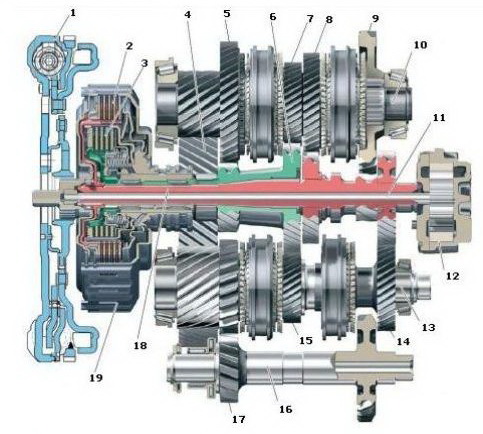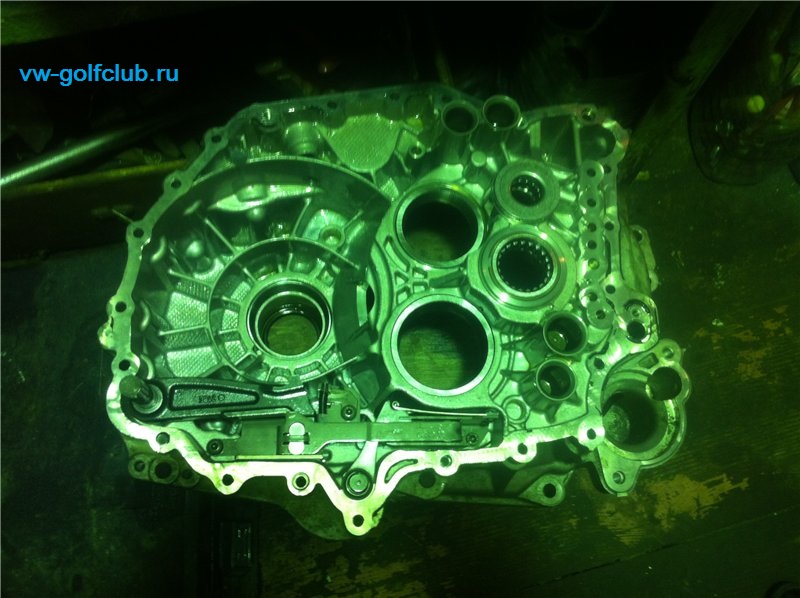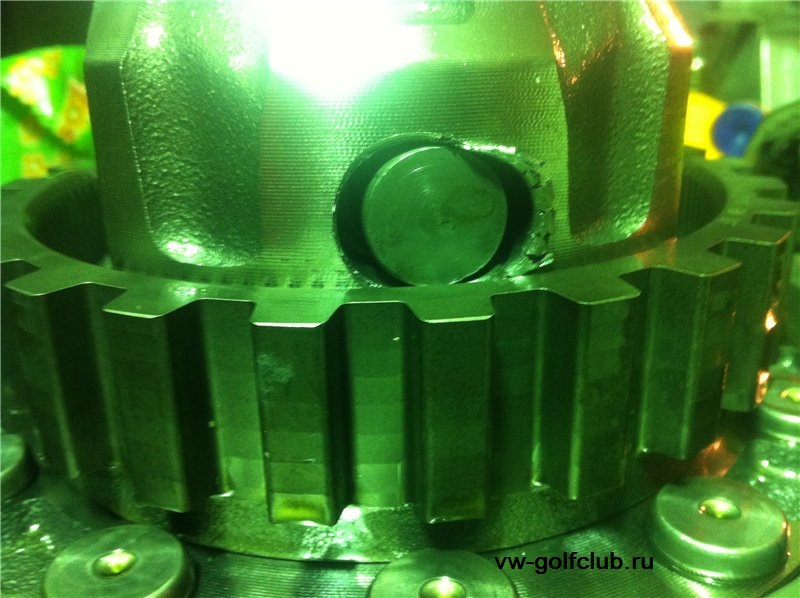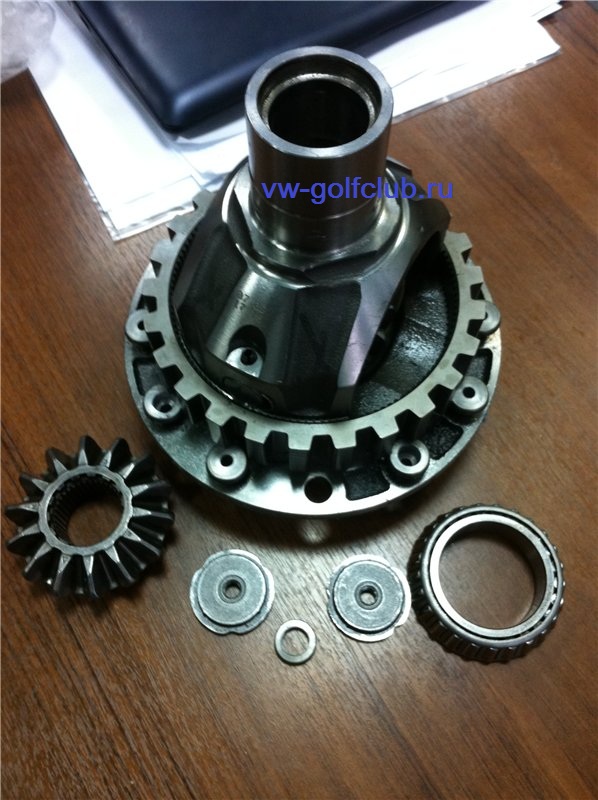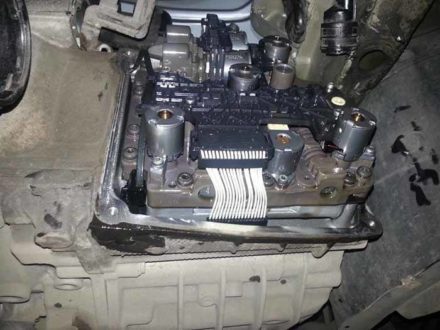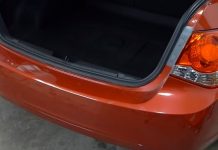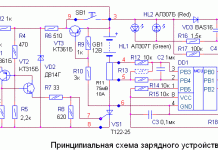In detail: do-it-yourself repair of the DSG 6 box from a real master for the site my.housecope.com.
In general, the story began back in September of that year, after replacing mechatronics on a kulanets about the great and mighty AvtoGanza
for which, of course, many thanks to them, but not for long.
Anyone interested can read the topic on the GTI-club (in the search, just type in autogans)
And so I will describe in a nutshell, in general, the DSG began to die, the dealer sent me when I arrived with him with a box completely in oil after 3 thousand runs after replacing the mechatron with them. in general, they sent me doing a fool, but it did not work out, complained to all instances, they got a stick, but it is very difficult to deal with them and I did not go to court.
In general, the whole story at the GTI-club
And here I will describe my last actions.
Well, let's discuss once again our smartest and most courageous dealers?)))
In general, I finally disassembled the DSG)
This is how she is DSGovina
We begin to disassemble in order. I loosened all the body bolts at once (22 pcs.)
Next, remove the link
here is the clutch itself in a semi-disassembled state
this is how the cover was removed from the clutch package itself, 5 narrow clutches are visible inside, everything is in excellent condition
also in the photo you can see a "stick-tube" - this is the secondary shaft of the gearbox, it is located inside the input shaft, rotates even gears, and the internal clutch clutches (the system is, of course, tricky and at first glance you can't figure it out, but if you weigh everything, then there is nothing supernatural there, solid mechanics)
Oh yes? I almost forgot, we also remove the mechatronics, of course)
We also remove the oil pump cover from the side, remove the pump itself, in order to then remove the two locking shafts holding one of the shafts for further “halving” the gearbox
We unscrew the inner parts of the drives. I had to face a small problem. You need a 7 hexagon but a decent length.
We remove 4 retaining rings, 2 from the side of the oil pump, 2 from the inside of the "dome" of the gearbox, we also remove the magnetic ring from the drive of the input shaft, it is simply pulled off.
Remove the gear shift fork, loosen all the bolts and “half” the DSG)
| Video (click to play). |
this is how it looks in section)
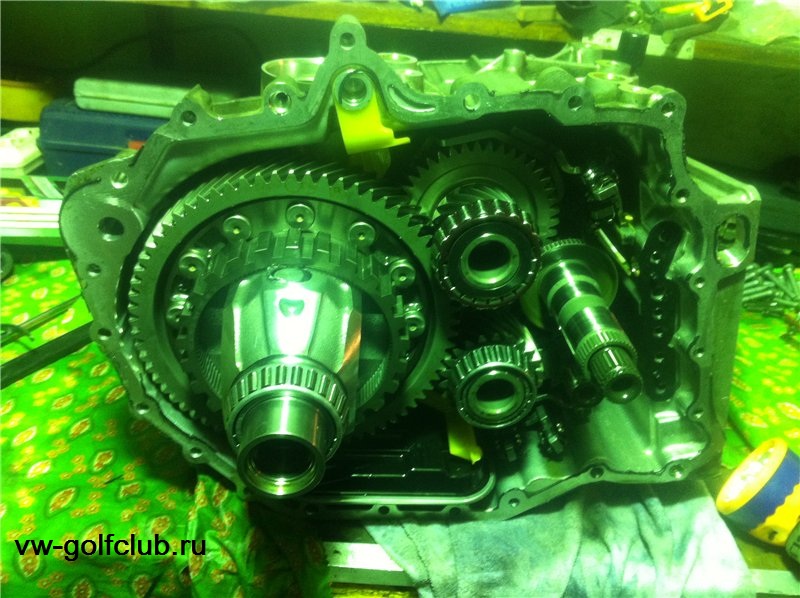
carefully remove the differential together with the GP
And now we carefully examine everything and understand that the gearbox itself is in excellent condition, I did not see wear on the gears at all, but we pay attention to the differential itself and we see such a picture
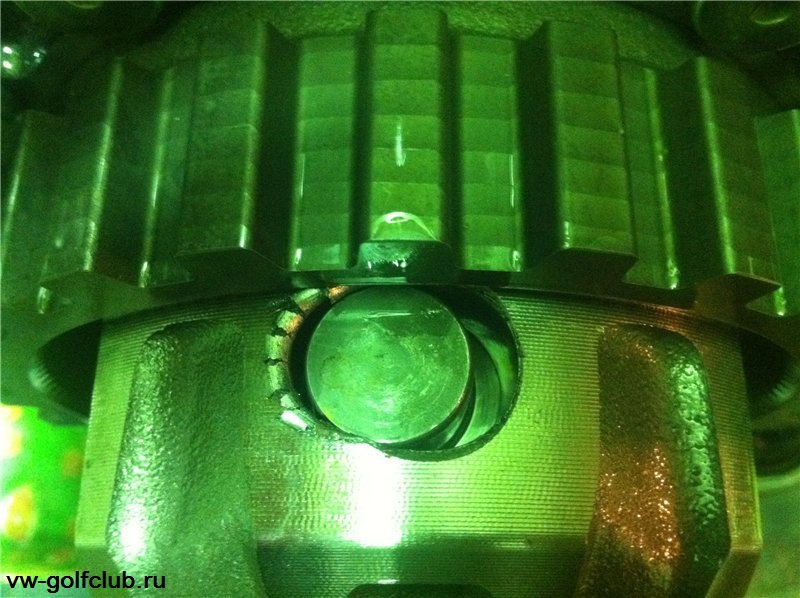
This is a broken hull. pichalka (
Hint, this oblong hole is generally round from the factory.
It can be concluded what shock loads the diff undergoes when one of the wheels slips and further sharp adhesion to the road surface.
Next, we see a fine filter that stands inside the gearbox itself at the bottom, it has magnets, and it works!
Now we drill out the rivets of the stock differential to remove the GP)
We wash the box inside, collect all the shavings.
We change the bearings on the diff.
Well, then we collect everything in the reverse order, then I will definitely write it off.
This is a stock diff, or rather, not assembled, but disassembled)
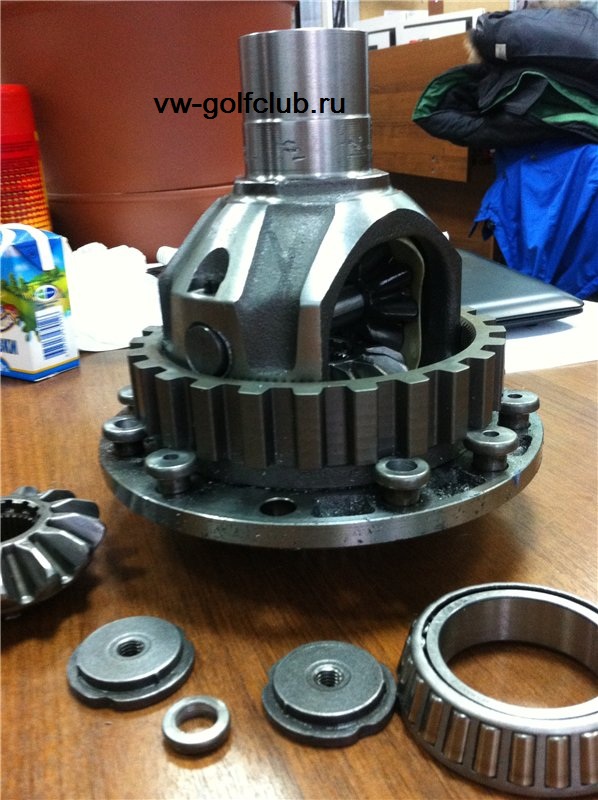
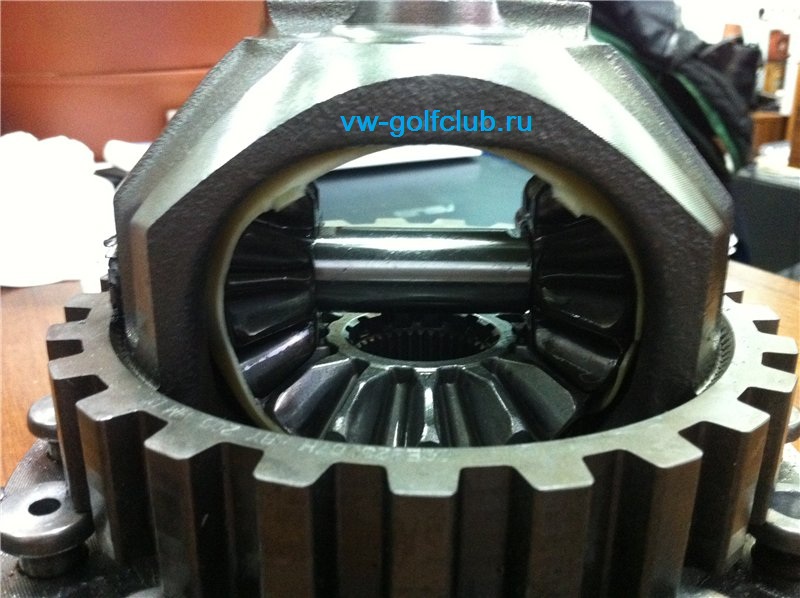
These are the rivets that I had to tinker with seriously. For this, a separate respect to my bata) Will never refuse to help, even scored for half a working day)
And this is Quaife, although so far without pressed bearings and not completely upset on the GP
Bolts (ARP) with which it is attached instead of rivets
I specially unscrewed one bolt so that there were more questions)
P.S.
Therefore, when the car “jumps” there was even such a theme, you rape the diff. when slipping is the same. So there are two ways out:
Everyone should install a limited-slip differential and motor supports (at least an insert in the lower one) in order to prevent the motor and gearbox from swinging and, as a result, to reduce shock loads on the drives, all together this will save our beloved DSG.
All successful use of DSG and as careful as possible with it
Anyone interested in ask questions, get answers)
I consider this personal knowledge, which is not a small effort, not only physical.
No offense to everyone, contact in a personal!
The DSG gearbox is used in many Volkswagen Group vehicles equipped with automatic (robotic) automatic transmissions. DSG 6 stands for Direktschaltgetriebe in German, and the English documentation uses the term Direct Shift Gearbox. Number 6 indicates the number of transmission stages.
The box in question is one of the so-called "robots". In the gearbox of the DSG family, the process of changing the gear ratio is automated, but the gearbox is based on the same classic "mechanics", supplemented by control units and hydraulic servo drives. The gears of the box are shifted by means of synchronizer clutches, but they are driven by the clutches hydraulically. An electronic unit called "Mechatronic" controls the coordinated work of the ensemble of box components.
This is what this block looks like on a disassembled box:
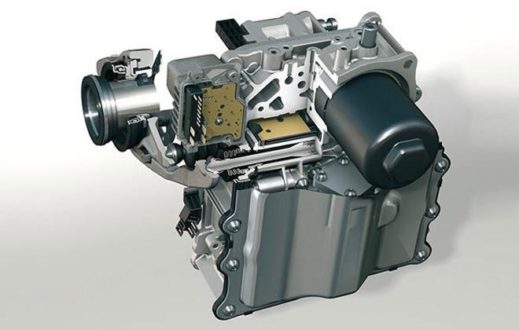
The box block reads the readings of many sensors:
- frequency of rotation of the input and output shafts of the DSG box;
- oil pressure in the box and its temperature;
- shift fork positions, etc.
Analyzing this data, the electronics decides on the selection of the desired gearbox mode.
DSG 6 (model DQ250) was developed in 2003. At the factory, the box is labeled as VW02 E, a distinctive feature of this box from the 7-speed "elder friend" released three years later - the so-called "wet clutch". This means that the gearbox disc packs are constantly immersed in an oil bath and operate under constant lubrication and cooling conditions. This significantly increases the resource of both the disks themselves and the box as a whole.
Schematic box arrangement:
- double clutch box;
- crankcase;
- differential gearbox;
- two rows of gears;
- control unit of the "Mechatronic" box;
- main gear.
The dual clutch transmits torque to the gear rows of the gearbox. The drive disc of the box is connected to the friction clutches and the flywheel by a special hub, which also integrates the gears.
The first row of gearboxes operates with odd gears and reverse gear. The second, respectively, serves the rest of the transmission stages.
The ECU is located in the box body, in the crankcase.
An equally important element is the electro-hydraulic unit, which carries out all physical operations to change gear ratios in the box. Its main components:
- control and solenoid valves of the box;
- a multiplexer generating a control signal;
- box distribution spools.
When the driver moves the box selector to one of the positions, the box distributors are activated. Gears are changed by means of solenoid valves, and the adjustment of the clutch clutches is carried out by pressure valves. Therefore, these valves can be called the "heart" of the box, and "Mechatronic" - its "brain". The DQ250 box multiplexer controls the hydraulic cylinders. In DSG 6 there are 8 of them, but at the same time a maximum of 4 valves of the box are involved. When the multiplexer uses one mode or another, different cylinders are activated, depending on the gear selected on the box.
Typical DSG gearbox selector:
Thus, the DSG 6 box operates on fairly simple shift algorithms, changing gears cyclically. At one moment, two rows of gears are involved, but the second (currently inactive) is still working, just not used. If the gearbox changes the gear ratio, the row is activated without restarting, passing into the activity phase. This allows you to reduce the time for changing gears literally to a fraction of a second, making the movement of the car smooth and accurate, without the "thoughtfulness" characteristic of slower gearboxes.And this approach allowed giving the box the name "preselective", since the desired gear is always ready to go.
An important point is the completion of boxes built on DSG technology with the Tiptronic system, which allows the gearbox to be switched to manual control mode.
Both developers and drivers using these boxes note a number of positive points:
- reduced fuel consumption (according to some statements, up to 20% compared to traditional
- mechanical box
- smooth movement;
- reduction of the time required for acceleration;
- Convenience of box control.
As in the automatic transmission, the clutch pedal is absent here, and the gearbox selector is familiar to anyone who has encountered an automatic transmission.
But there are also disadvantages. The most important of them is the price: a car equipped with a DSG unit is more expensive than its class and model range counterparts. In addition, it is not always possible to avoid the "thoughtfulness" of the box: the DSG sometimes does not keep up with the dynamics of vehicle acceleration, and switching occurs with some delay. The electronic unit of the box, according to reviews, is another weak point: the mechatronic DSG 6 periodically fails and requires maintenance or replacement. And the drivers note the increased heating of the box due to the constantly active preselector.
Scheduled maintenance of the box will also cost a little more: for replacement, you will need from 6 to 6.5 liters of special gear oil. DSG-7, for example, due to the use of "dry" technology consumes less liquid, about 2.5 liters.
In general, the design of the box is less maintainable, in comparison with the "mechanics", and in some cases it will be necessary to change the box as a whole. But with proper service, DSG 6 claims a box resource of up to 250 thousand km.
So, DSG 6 - on which models this automatic transmission is installed
As already mentioned, a number of cars produced by the VAG group are equipped with this box. The heavy (93 kilograms) DSG 6 delivers up to 325 newtons of transmitted thrust, which is suitable for medium to high power engines - from the popular 1.4-liter engines up to 140 horsepower, up to the 250-horsepower 3.2-liter V-6 engines. The engineers decided that a less heavy (70 kg) and not so "high-torque" model of the DSG-7 box would be installed on low-power machines.
The gearbox in question is actively installed on cars Volkswagen:
Subject to the proper operating rules, the DSG 6 box is quite reliable, has a long mileage resource and fine tuning capabilities. But the design features also caused some problems of the box.
Most often, the "disease" is manifested by jerks of the box on the inclusion of even gears or the loss of reverse gear. At the same time, the box goes into emergency mode, prohibiting the change of gears, and information about errors gets into the automatic box unit.
In this case, there is only one repair method - either replacing the entire clutch or individual friction discs (if the vehicle's mileage is up to 150 thousand km). If the entire clutch was replaced on a DSG 6, the gearbox must be adjusted with a proprietary diagnostic device, it is also advisable to adapt the DSG 6 clutch in motion. Adaptation is also needed when replacing disks.
Another typical misfortune of these boxes, which manifests itself as "kicks" of the automatic transmission. At the same time, the DSG box does not go into emergency mode, there are no errors in memory either. You can fix the problem by replacing the mechatronics or broken solenoids.
In this case, the box can go into emergency mode when starting "cold". If the driver restarts the motor, the box error goes away. At a random moment in time, the box can again become "emergency", even in motion, and the block memory records errors. The breakdown is eliminated by repairing the unit (if possible), or by replacing it.
These malfunctions of the box are manifested in the form of increased noise coming from the depths of the box when driving. The noise from the bowels of the DSG increases when cornering, when throttle is added, when braking or accelerating.If you do not pay attention to the problem for a long time, other structural elements of the automatic transmission also fail, the mechatronic of the box becomes clogged with metal shavings, the clutch wears out intensively. In this case, the box needs a major overhaul or complete replacement. Repair of DSG boxes is quite difficult in itself, in addition, the manufacturer does not supply some of the parts to the market, and you will need to look for them from sellers of used spare parts and at "disassembly".
A malfunction of the box is manifested by clanking and extraneous noise in idle mode, when the engine is started and the ignition is turned off. The solution is to replace the flywheel.
Driving a car with a DSG box, the driver contacts the transmission only through the selector. Therefore, it will not work here to "stick" the wrong gear on the box. The manufacturer recommends following a few basic rules:
- try to drive without slipping;
- stand in traffic jams as little as possible with the brake depressed;
- timely change the oil in DSG 6, using only the recommended fluid;
- in winter, start moving smoothly, giving the box time to warm up.
It is important to pay attention to any suspicious behavior of the box:
- kicks when switching boxes;
- disappearance of reverse gear;
- unexpected transitions of the box to emergency mode;
- extraneous noise;
- loss of dynamics by the car, significant delays in changing the gearbox ratio.
If these symptoms appear, you should contact an authorized service center as soon as possible for diagnostics and repair of the box.
VAG emphasizes: regular replacement of the transmission fluid is a necessary procedure for a long and reliable operation of the box. It is recommended to carry out the procedure every 60 thousand km. mileage of the box, but in Russian conditions, in practice, it is advisable to do this more often - every 40 thousand.
Replacement requires 6 liters of VAG gear oil G052182A2, an O-ring for the drain plug (part number 91084501) and a new oil filter with part number VAG 02E305051C.
Some car owners prefer to save money by purchasing an oil with similar tolerances, for example, Pentosin FFL-2.
This is permitted, but different oils cannot be mixed with each other. That is, if one is poured into the box, you must first completely remove it, and then pour another into the system.
It is not recommended to use universal oils for the DSG box, such as Motul Multi ATF or similar Castrol products.
Changing the box fluid can be done in several ways:
- at a dealer or in a car service, on a special device;
- on one's own.
The first method gives some guarantees, but it will cost more: taking into account the work and consumables, the service is able to issue an invoice of 10-15 thousand per operation. You can try to save several thousand by doing the procedure yourself.
The process consists of several stages.
- Lifting the car on a lift or driving into an inspection pit.
- After that, the engine should be turned off, and the gearbox selector should be moved to the Parking position.
- Next, the drain plug of the box is unscrewed.
- After that, about a liter of the old transmission fluid will pour out of the box pan. Next, the control tube is removed with a hex wrench, and the rest of the oil from the automatic transmission will start pouring out.
Important: you should visually check the presence of foreign inclusions in the oil, for example, metal shavings. If they are present, the box is in poor condition and will break soon, an early visit to the service center is desirable.
- Next, you need to remove the oil filter of the box, for which you will have to dismantle the battery and its mounting platform, and for convenience it is better to remove the air filter with air ducts.
The box filter cover is unscrewed by two turns, then you should wait until the remaining liquid drains into the crankcase cavity, remove the entire cover and replace the filter.
- The next step is to fill the box with new oil.
You can do this directly through the filter housing, but the process will then take quite a long time, a liter of liquid will be poured into the box for about 10 minutes.
You can do otherwise by purchasing in advance an adapter into the hole of the oil drain plug with a transparent hose about 2 meters in length. One end is screwed into the hole of the box, a funnel is placed on the other, which should be fixed, for example, on a side mirror, so that a difference in height is created. You need to pour 5-6 liters.
- Then you should start the engine and warm up the box by sequentially switching the accelerator modes.
This is necessary for the oil in the box to warm up, and the driver can check its level. Then the funnel is unscrewed, and the remaining oil bottle / canister is placed in its place. The container is placed below the box - that is, on the floor. Excess liquid will drain into the vessel. When the flow stops and only small drops remain, the adapter is unscrewed and the plug is returned to its place.
Do not twist it tightly yet. The engine starts, the gearbox modes are "run", the selector returns to Parking.
- Then the plug is unscrewed again, if excess oil remains, they need to be allowed to drain to the level of the overflow hose.
In their absence, the addition procedure is repeated until the desired level is reached. After completion, the DSG plug, together with the seal, is screwed into its original position.
According to official guidelines, it is imperative that the oil temperature is 35 degrees during the checks. This is why you need to "warm up" the DSG box.
In car services, the temperature parameters of the liquid are controlled by a special device by another car computer / program with the VAG-Com communication interface:
Without a device, you will have to rely solely on tactile sensations, which, in theory, can lead to over- or underfilling of oil, which are equally harmful to the DSG. In practice, many car owners carry out the procedure on their own, without prejudice to the automatic transmission.
As you can see, the DSG 6 transmission, despite a rather complex technical device, shows a fairly high reliability, provided that the proper operating rules are followed, and the oil change service procedure is available even to a simple car enthusiast without special knowledge. The DSG box provides high dynamic characteristics of the car and the level of user comfort.
After the active introduction of robotic gearboxes into mass production, the Volkswagen DSG gearbox has become one of the most common options on the market.
The specified gearbox at the start of sales became a real innovation among other automatic transmissions. The DSG box successfully combines the positive aspects of "classic" automatic transmissions (comfort) and manual transmissions (fuel efficiency).
At the same time, in practice, the reliability of the DSG transmission was not as high as the manufacturers themselves stated. Taking into account the design features, the weak point turned out to be a number of actuators and electronic components, as well as the DSG clutch. Next, we will look at how the clutch replacement is performed on a DSG.
So, the DSG preselective robotic gearbox is available in different versions. We are talking about the DSG-6 and DSG-7 Volkswagen, as well as the Audi S-tronic.
The clutch in such gearboxes resembles in its structure and principle of operation a similar mechanism on a conventional "mechanics", however, in the case of DSG robots, there are two such clutches at once, and the clutch is also "wet" and "dry" depending on the type of gearbox. The so-called "wet" clutch means that it operates in an oil bath.
- At the same time, as practice shows, the most problematic option was the DSG7 with a "dry" clutch. After the release of such a modification, the owners of different car models were often forced to contact the service due to problems with the DSG-7 gearbox and clutch after 20-30 thousand km. mileage.
At the moment, the manufacturer took into account individual shortcomings and even at some point expanded the warranty on the gearbox, referring to the fact that the DSG box has become more reliable. However, for all the time, many cars from the first batches have been sold, and the warranty period for them has long since ended.
Also, not all problems were eliminated on new versions of the transmission. In simple words, many owners of cars with DSG have to deal with the need to replace the DSG clutch or repair the gearbox. Moreover, all operations with this type of transmission are expensive compared to analogs.
- Not surprisingly, many are trying to do DSG7 repairs with their own hands. Immediately, we note that although a manual gearbox is the basis of preselective robots, such a box is a rather complicated unit in technical terms, experience and certain skills are required for repair and maintenance.
First of all, before starting to change anything, it is recommended to start with a diagnosis. If during the check it turns out that the problem is in the clutch, then you will need to purchase a LUK clutch for DSG7 or a DSG clutch repair kit.
The next step will be the acquisition of a DSG clutch replacement tool kit. At the same time, it is important to understand that such a set is quite expensive. For this reason, it is advisable to team up with other owners of cars with DSG robotic transmission.
This practice is becoming more common, especially in auto clubs among owners who wish to service the car on their own. If this is not possible, then you need to be prepared for the fact that difficulties arise, you will need to select the necessary tools separately.
The availability of all the necessary tools is an important condition, as it allows you to easily complete the entire list of operations (replacement of the DSG disc, complete replacement of the clutch package, etc.). What's more, the LUK mounting kit also includes detailed instructions on how to change the clutch.
| Video (click to play). |
-
- All work begins with dismantling the gearbox. It is optimal to have a suspension mechanism, which will allow the gearbox to be fixed before unscrewing the fasteners.
- Before removing the clutch from the gearbox, check the transmission oil level. If the level is below normal, the oil is dirty, oil smudges are visible, etc., it is better to replace such oil in full.
- Further, the clutch is removed using tools from the kit or those that are available. When removing, remember that the adjusting ring can be both above and below in relation to the pressure bearing (depending on the clutch model).
- After removal, you need to thoroughly wipe the input shaft of the box with a mild cleaner that does not contain aggressive solvents. There is no need to remove grease on the shaft splines. The shaft seal is also checked in parallel.
Along with the cable, the kit should contain a manual describing a number of manipulations, the VAG-Com program, mechatronic data related to the clutch, etc. As for the general rules for adapting the DSG clutch, after connecting the cable, the temperature of the transmission oil in the gearbox should be kept at an average level of 35 to 90 degrees Celsius.
The selector lever must be set to “P” mode, start the engine and let the unit idle. The brake pedal must be depressed during adaptation, the accelerator pedal must not be depressed.
As you can see, the process of replacing a clutch on a robotic DSG gearbox is not difficult, provided that there is experience in carrying out such work (removing a gearbox, installing a clutch, performing a calibration, etc.).
At the same time, the operation is laborious, and to simplify the process as much as possible, a special set of tools is required, as well as a diagnostic cable for the subsequent adaptation of the DSG clutch.
If we add that clutch problems for preselective robotic gearboxes are not uncommon and occur quite often in the process of active vehicle operation. It becomes clear that in some cases, self-service of a car with DSG is the best solution.

